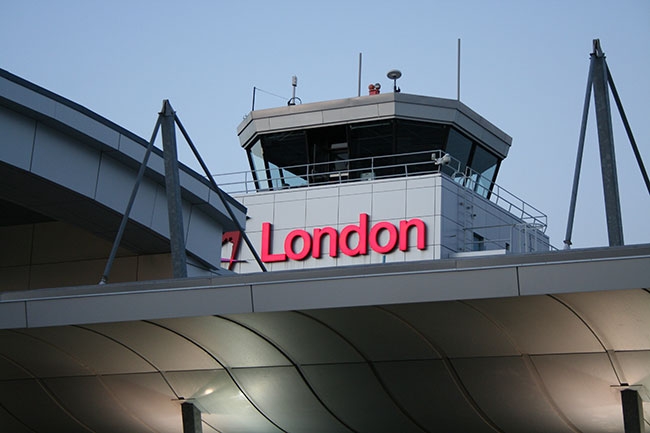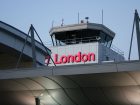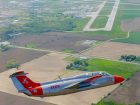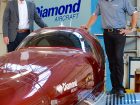
News
Uncovering hidden gems
Hey Matt, are you OK back there? Are you ready for some fun?”
June 22, 2017 By Matt Nicholls
 London International Airport had 514 Hey Matt
London International Airport had 514 Hey MattIt’s a question I was expecting and to be completely honest, wasn’t sure how to respond. Excited? Apprehensive? Psyched?! They all fit the bill. “Ok, let’s go . . . let’s do this!”
I’m sitting in the jump seat of a Douglas A-4K Skyhawk training aircraft with the team from London, Ont.-based International Test Pilots School Canada (ITPS), one of the key stops on my recent tour of the London International Airport and its an impressive aerospace hub.
We’re doing an air-to-air photo shoot with the ITPS team and I’m in the trusted care of one of its top military pilot trainers: Sèphane Logette, head of the training organization. I’m in good hands. With 24 years of flying experience as a test and fighter pilot, Logette has an extensive background on more than 40 aircraft. His experience, professionalism and attention to detail is immediately apparent, as he goes through a number of safety checks and preflight instructions. ITPS has a staff of 10 highly qualified military training instructors and it has been active at the airport since 2009.
The stakes for the flight are high. Mike Seabrook, president and CEO of the Greater London International Airport Authority (GLIAA) which operates London International Airport (XYU), has been a gracious host for the day. He has given me one task: take a great shot of a Skyhawk over the airport. Seabrooke needs one to accurately showcase the hidden gems like ITPS that showcase the eclectic aerospace mix at YXU – a mix of aviation craftsmen, business aviation and aviation and aerospace training leaders.
Thankfully, our half hour flight is an unqualified success. We get a selection of great shots and for me, it’s an unforgettable experience – I do feel the need for speed! Mission accomplished!
An international leader
ITPS is an intriguing addition to the airport’s aerospace footprint – an international success story in southwestern Ontario. The company offers a range of training course for test pilots and flight test engineers from around the globe. The training that pilots receive in London reflects lessons its test pilots have learned throughout their careers on a variety of fixed- and rotary-wing aircraft. All training is up-to-date, effective and affordable and gives students a chance to do so in a community-oriented environment.
The company has 23 employees and has a mixed fixed-wing fleet of training aircraft and simulators including Skyhawks, an Embraer EBM 314 Super Tucano, Cirrus SR22, Rockwell Commander RC700, Aero L-39 Albatros and Bucket Jungmann. Rotary trainers and SIMs include an MBB BO-105M, Leonardo AE119Ke, Airbus H120 and an Airbus AS350 Squirrel. Students and clients come from around the globe, to either train on new aircraft types or extend their skills to become training pilots themselves. Most often, their families join them for the training period and ITPS offers them accommodations in 11 offsite houses.
“All of our students are highly experienced pilots, they are training to be test pilots. And most of them are engineers as well,” notes Giorgio Clementi, president, test pilot and engineer, with ITPS Canada. “They have engineering degrees, some have masters in engineering. They come to us for a year and we teach them to plan and execute flight tests for the whole spectrum of measuring quality, safety, flight patrol systems training, avionic testing, the whole gamut. It is a fully-fledged test pilot’s school. We expect to be an approved test pilot training organization by EASA.”
Clementi has 34 years of flying experience of which 20 have been in flight-testing. He set up shop in London after a long and successful international aerospace career after being contracted by Diamond Aircraft to set up a flight test department in Canada. He conducted initial proof of concept flight test for the D-Jet Prototype as well as the whole Diamond piston engine line. He moved over to set up the ITPS in 2009 after the D-Jet program was put on hold.
“We are in expansion mode and will be building a new facility on the field shortly,” Clementi says. “And we are really happy with London. Years ago I used to think, London, really? Who’s going to come to London? People would often say, London, England? But this has not been an issue. Canada is a very popular destination with pilots that want to be instructors. The country is very well known in aerospace, so it doesn’t make it a tough sell.”
A Diverse Mix
Clementi’s experience as a tenant at YXU has been a positive one, and it’s a sentiment shared by other aerospace tenants Wings visited on its tour. Operated by the Greater London Airport Authority as a not-for-profit organization, YXU is a bustling aerospace hub that offers a unique blend of services, including a strong commercial footprint that includes airline service from Air Canada Express, WestJet, WestJet Encore, Sunwing, and Air Transat.
With a main runway of some 8,800 feet (200 ft. wide) and a secondary runway of 6,300 ft. (200 ft. wide), YXU is capable of accepting a range of aircraft, including wide body aircraft. The airport is classified as an airport of entry by NAV CANADA and is also staffed by the Canada Border Services Agency. It is also a key member of the new Southern Ontario Airport Network, working to unlock the demands of aircraft capacity in the region.
The numbers certainly tell a tale of success for YXU. In 2016, for example, the airport had some 514,685 commercial passengers and 94,747 aircraft movements, making it the 20th busiest airport in Canada. Its success is mainly predicated on a diversified revenue base with a foundation built on efficient operations and low fees for businesses operating at the airport.
YXU is home to more than 50 businesses, collectively employing 1,700 professionals, ranking it in the top 10 employers in the London area. YXU generates an economic impact in excess of $357 million, and businesses at the airport run the gamut from aircraft maintenance, to business charters, aviation training, manufacturing, education and research and more.
And the good news for London is there’s room for plenty of growth. The airport itself is situated on about 1,500 acres, notes Seabrook, and there is a real opportunity to attract new businesses to the site.
“We have just under 400 acres that is serviced to date, so, we have a lot of land, a lot of development opportunities,” Seabrook says. “We also have long runways, a terminal building that is in good shape, our financial model is extremely viable, and we operate at a surplus every year. So, it’s a very attractive site for new companies coming in.”
Seabrook notes that there are some solid leads in the pipeline for future aerospace businesses at YXU and he is actively working with the London Economic Development Corporation (LEDC) on future business. “There really isn’t a specific sector were are targeting,” Seabrooke notes. “Any sector of aviation we would like to take a shot at. It’s just a matter of being persistent and working with the economic development team to try to get them here.”
Growing the commercial passenger experience at YXU also has potential. The future development of ULCC airlines could help in this regard. “We are under-utilized passenger wise in London and I would like that to change,” Seabrook says. “Our studies indicate that passengers love our airport, we are convenient, but they want more service. Unfortunately in Canada we have two main carriers and they have their network. We hope that with the development of ULCC carriers we will be an optimal secondary airport for them to choose.”
Maintaining a close working relationship with the LEDC is also paramount for future expansion. It’s a partnership that has been a solid one, mainly because both parties have a clear understanding and vision of the value that YXU brings to the local economy.
“Airport development helps the business development of the city,” notes Kapil Lakhotia, president and CEO of the LEDC. “We have a well-balanced economy in London ¬– a healthy balance over a variety sectors that share the pie equally, such as manufacturing, finance and insurance services, education (Western, Fanshawe, school boards), hospitals and health care. And between white collar and blue collar, we have a good mix of occupations and income levels.
“All of this sets up the perfect ecosystem for talent attraction. Whether it is for leisure or business travel that is just one element. There are also cargo opportunities, MRO, commercial business . . .there are many possibilities.”
As Lakhotia points out, not a lot airports in Ontario boast high quality educational programming, manufacturing and MRO facilities all in one place. Fanshawe College – with its excellent Norton Wolf School of Aviation – and Western University, both offer comprehensive aviation and aerospace programs, while Diamond Flight Centre (DFC), is one of the nation’s premier flight schools.
DFC is part of a network of Diamond flight training schools in North America, and provides high-quality flight training using Diamond aircraft and Diamond-specific flight training simulators.
YXU is a great training spot for students, because it is busy enough that students acquire experience with traffic, yet is generally quiet enough so that students can practice in a relaxed atmosphere without long waits for clearance. The school’s training fleet includes Diamond C1, DA40 and DA42 aircraft. Advanced simulator training is also available.
Diamond Flight Centre is affiliated with Western University’s excellent commercial aviation management (CAM) program, which offers students a stepping-stone to a career in aviation. CAM students graduate with a bachelor’s degree in management and organizational studies (BMOS), with specialized courses in aviation management. CAM students graduating with the flight option receive a bachelor’s degree in management and organizational studies and a Transport Canada approved integrated commercial pilot’s license (ICPL) with multi-engine and instrument ratings.
“All of this builds up the profile of the airport here a lot differently than some of the others in Ontario and Canada,” Lakhotia notes. “And while it is important to chase passenger and cargo service, it is equally important to bring in education providers, or develop more entrepreneurial businesses.”
A Diamond in the Rough
Arguably the highest profile aerospace tenant at YXU is Diamond Aircraft, one of Canada’s leading aerospace companies and manufacturers of an impressive line of all composite aircraft competing on the world stage in a general aviation, training and business aviation sectors.
Boosting a state-of-the-art, 220,000 sq. ft. manufacturing facility on some 55 acres of land at YXU, Diamond creates a full line of aircraft including the DA62, DA42, DA40 NG, DA40 Tundra, DA40 XLT, and DA20 models. The company also does specialized composite structure work on the Dornier Seastar, creating its fibreglass fuselage.
Last December, Wanfeng Aviation, a division of China-based Wanfeng Auto Holding, purchased a 60 per cent share of Diamond Aircraft. Under the terms of the agreement, production of the high-end DA62 moved to London, along with the diesel version of the single-engine, four-seat DA-40.
Research and design of both aircraft was also transferred. The result means a boost in manpower at the Diamond facility, which could bring employment from approximately 150 employees to twice that. Wanfeng Holding also owns the DFC.
London’s Diamond plant will also produce the DA-20 model. It’s a great bounce back position for the company, which was dealt a blow in the spring of 2010 when the federal government refused its request for a $35 million loan to support its fledgling D-Jet program, promoting a number of layoffs. The program is in hiatus mode, with more than 300 orders on hold.
The north hangar dedicated for the D-Jets program has also been refurbished and is being leased to Northrup Grumman Canada for the development of an unmanned surveillance aircraft. Diamond is partnering with Northrup Grumman on the UAV project.
Diamond is now focusing on its strong demand for its popular all-composite models, and a tour of the facility reveals a bright, modern, well-organized and highly functional site. The roots of the company are proudly displayed throughout the lobby area, and there’s a positive vibe from the staff throughout.
“One thing about Diamond that is impressive is we are vertically integrated. We build a lot of our own parts and supply to ourselves,” notes Scott McFadzean, COO, Diamond Aircraft. “And frankly, it’s so exciting to work here. It’s such an innovative company with the best airplanes in GA, and I’m saying that as an aviation fan not just an employee. It’s great for Ontario and Canada.”
In terms of market penetration, Diamond’s bread and butter is the U.S. market, but European sales are steady and Australia, New Zealand have potential. “And with our new investors, we are also targeting China,” McFadzean says. “The DA62 program gives the team a great product to grow around. We are looking for people who have moved up in their flying, people who are looking for the next step . . . the high performance single-engine market.”
Companies on the move
Diamond Aircraft isn’t the only company at YXU in expansion mode. Executive Aviation, a premier fixed based operation (FBO) and ground handling services company, is now operating as an FBO in London, Sault Ste. Marie and Sudbury, and has expanded its ground handling services to seven locations across Ontario. The company has 40 employees in London, and offers a variety of services and amenities to a wide selection of clients.
“It is a very white collar city so we have a lot of financial companies. But we also see a lot of doctors come through with their own aircraft, and we also see some cross country travel,” notes Glenn Wickert, general manager, Executive Aviation. “We also get a lot of American registrations.”
So what sets the London location apart from other FBO services? “I think we are also different than a Toronto or Calgary FBO in that we can get a little more personal,” notes Nelson Bradshaw, president of Executive Aviation. “It’s very one-on-one, we know a lot of our clients, a lot of repeat clients. We will never be a Million Air, but we don’t want to be either.”
A chance to offer more personalized service and develop a solid client base has served Chris Eaves well for years. The DOT AMO of maintenance structures at MRO repair specialist XU Aviation is the oldest tenant at YXU at 40 years. His team works on a variety of projects in the company’s 8,000 sq. ft. hangar, including GA, recreational aircraft, racing aircraft (Red Bull ace Pete McLeod is a client), Diamond aircraft repair and more. Eaves has a particular interest in gliders, which are composite structures similar to those manufactured at Diamond. It’s just one of the synergies tenants seem to share at YXU.
The chance to expand a customer base in a vibrant new market, is also the driving force behind the relocation to YXU of avionics specialist Midland Instruments Ltd. Originally based in Midland and Collingwood, Ont. the decade-old firm specializing in avionics installations, upgrades, STCs, maintenance and more and is eager to expand its markets in a more dynamic location.
“We are looking forward to having the support and the infrastructure that YXU offers,” says Vince Scott, founder and president of Midland Instruments. “I know a few people here and under the direction of Mike (Seabrook), the airport has really turned around. There is plenty of opportunity and growth potential here.”
Working with a clear vision
Growth opportunities, dynamic partnerships with industry and educational institutions, sound working relationships with the city and a solid, functional infrastructure. They’re all key elements in the success of the YXU aerospace hub and its bright future.
“We have done two or three strategic planning sessions, and our airport board of directors is on the same page as we are. They get it, they are progressive, they understand the processes that need to happen,” Seabrook notes. “We have great staff, and they trust and believe in management. I think this is probably the thing that is our ace in the hole as we go forward.”


